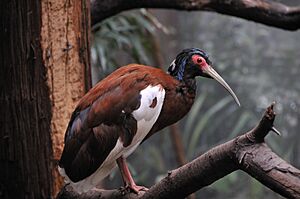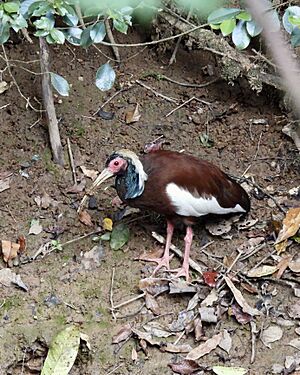Madagascar ibis facts for kids
Quick facts for kids Madagascar ibis |
|
|---|---|
 |
|
| At Bronx Zoo, New York, United States | |
| Conservation status | |
| Scientific classification | |
| Synonyms | |
|
The Madagascar ibis (Lophotibis cristata) is a special bird found only on the island of Madagascar. People also call it the Madagascar crested ibis or white-winged ibis. It's a medium-sized bird, about 50 cm (20 inches) long. This ibis has brown feathers and bright white wings. Its head has a cool crest of green or blue and white feathers. It also has red skin around its eyes, a yellow beak, and red legs. This bird is the only type of ibis in its group, called Lophotibis.
Contents
About the Madagascar Ibis Name
The Madagascar ibis was first described in 1781 by a French scientist named Georges-Louis Leclerc, Comte de Buffon. He wrote about it in his book Histoire Naturelle des Oiseaux. Later, in 1783, a Dutch naturalist named Pieter Boddaert gave it the scientific name Tantalus cristatus.
Today, the Madagascar ibis is the only species in the group Lophotibis. This group was named by a German naturalist, Ludwig Reichenbach, in 1853. The name Lophotibis comes from ancient Greek words meaning "crest" and "ibis." The word cristata comes from Latin, also meaning "crest."
What Does the Madagascar Ibis Look Like?
The Madagascar ibis is about 50 cm (20 in) long. This makes it one of the bigger birds living in the forests of Madagascar. Its head is black, and its upper body is a reddish-brown color. The chin, neck, throat, and belly are dark brown. A big part of its wings are white.
Part of its face around the eye is bare and red. It has a crest of long feathers on its head and the back of its neck. These feathers are black and have a shiny, metallic look.
Different Types of Madagascar Ibis
There are two slightly different kinds, or subspecies, of the Madagascar ibis.
- In one type, L. c. cristata, the shiny feathers on its crest look green and have white spots.
- In the other type, L. c. urschi, the throat, neck, and crest have a greenish shine mixed with yellowish-orange. This type also has a darker brown body color.
The ibis has brown eyes. Its very long beak is horn-colored, which means it's a yellowish-brown. Its legs and feet are bright red.
Where Does the Madagascar Ibis Live?
The Madagascar ibis lives only in the woodlands and forests of Madagascar. It can be found in places up to 2,000 m (6,600 ft) high. You can see it in both old, untouched forests and newer forests that have grown back. This includes wet forests in the northeast and dry forests in the west and south of the island.
Diet and Reproduction
The Madagascar ibis mostly eats insects, spiders, frogs, reptiles, snails, and other small creatures without backbones, called invertebrates. It uses its long beak to probe the ground and find food.
When it's time to lay eggs, the female ibis usually lays three eggs. She builds a nest that looks like a platform. This nest is made from twigs and small branches.
Why is the Madagascar Ibis Important?
The total number of Madagascar ibises is going down. This is because their habitat (the place where they live) is being lost. Also, in some areas, people hunt them too much because they are a favorite bird to catch.
Because of these problems, the Madagascar ibis is listed as a near-threatened species on the IUCN Red List of Threatened Species. This means it could become endangered if we don't protect it.



